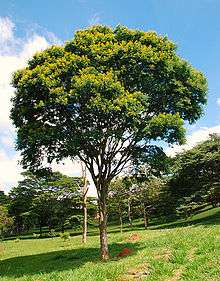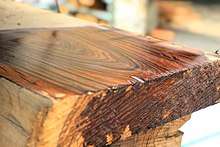Libidibia ferrea
Libidibia ferrea, formerly Caesalpinia ferrea,[1][2] and commonly known as pau ferro, Brazilian ironwood, morado, or leopard tree,[3] is a tree found in Brazil and Bolivia.
| Brazilian ironwood | |
|---|---|
 | |
| Scientific classification | |
| Kingdom: | |
| (unranked): | |
| (unranked): | |
| (unranked): | |
| Order: | |
| Family: | |
| Genus: | |
| Species: | L. ferrea |
| Binomial name | |
| Libidibia ferrea (Mart. ex Tul.) L. P. Queiroz | |
| Synonyms | |
| |
Wood
Most species of Caesalpinia s.l. have poorly defined growth rings, with isolated vessels arranged in radial multiples. Pitting between vessels is alternate and covered, and fibres are generally not divided by a septum. The axial (i.e., longitudinal) parenchyma varies from a winged shape to confluent, and is irregularly storied (i.e., layered), while the rays (perpendicular to growth rings) are of variable height and generally comprise a single or double cell width.[2] Libidibia in particular has layered longitudinal parenchyma and narrow homocellular (i.e., of uniform type) rays without crystals in the ray cells.[2]

Uses
Its wood is often used for making fingerboards for electric basses and guitars. It has a similar feel and similar tonal attributes to rosewood, but is harder and has a slightly lighter colour.[4] The wood may also be used for flooring, fancy furniture, and handgun grips. It is also known by the names morado, palo santo, caviuna, Brazilian ironwood, and Bolivian rosewood, though it is not actually rosewood.
In guitar making, pau ferro is mainly used for fingerboards and bridges. Some luthiers also use it for the back and sides of acoustic guitars. The Brazilian guitar company Giannini uses laminated pau ferro in many of their classical guitars.[5] Although similar in many ways to rosewood, pau ferro has slightly different qualities: Its colouration ranges from coffee brown to yellow brown and purple. The tonal characteristics are said to be between rosewood and ebony, with a slightly "snappier" sound, being "slightly brighter than rosewood but with the same depth and warmth".
Fender has utilized pau ferro on many of their instruments in recent years due to the increasing cost of rosewood due to CITES laws.[6] The Stevie Ray Vaughan Signature Fender Stratocaster was one of the company's first instruments to feature a pau ferro fingerboard.
Allergy information
Pau ferro, used as a rosewood substitute, is a strong sensitizer capable of causing acute outbreaks of allergic and irritant dermatitis in workers not previously exposed to it. This, however, has not prevented furniture factories from using the product. Apparently, most workers develop tolerance to the wood. The allergen is (R)-3,4-dimethoxydalbergion, a strong skin sensitizer.[7]
 A two-week-old specimen grown from harvested seed
A two-week-old specimen grown from harvested seed Bipinnately compound leaf
Bipinnately compound leaf.jpg) Inflorescences
Inflorescences_(3614079116).jpg) Seed pods
Seed pods
References
- Gagnon, E.; Lewis, G.P.; Solange Sotuyo, J.; Hughes, C.E.; Bruneau, A. (November 2013). "A molecular phylogeny of Caesalpinia sensu lato: Increased sampling reveals new insights and more genera than expected". South African Journal of Botany. 89: 111–127. doi:10.1016/j.sajb.2013.07.027.
- Gasson, Peter; Warner, Kate; Lewis, Gwilym (2009). "Wood Anatomy of Caesalpinia S.S., Coulteria, Erythrostemon, Guilandina, Libidibia, Mezoneuron, Poincianella, Pomaria and Tara (Leguminosae, Caesalpinioideae, Caesalpinieae)". IAWA Journal. 30 (3): 247–276. doi:10.1163/22941932-90000218.
- "Caesalpinia ferrea Mart. ex Tul". Germplasm Resources Information Network (GRIN). Agricultural Research Service (ARS), United States Department of Agriculture (USDA). Retrieved 12 February 2012.
- https://www.commercialforestproducts.com/pau-ferro-rosewood/
- classical giannini guitar
- "Fender CITES Changes - Rosewood vs. Pau Ferro Fretboards". Retrieved August 16, 2018.
- Department of Dermatology, Gentofte Hospital, Hellerup, Denmark